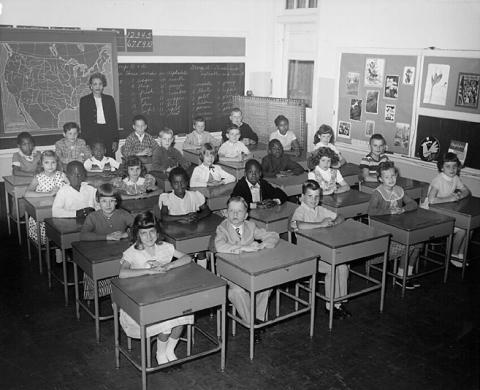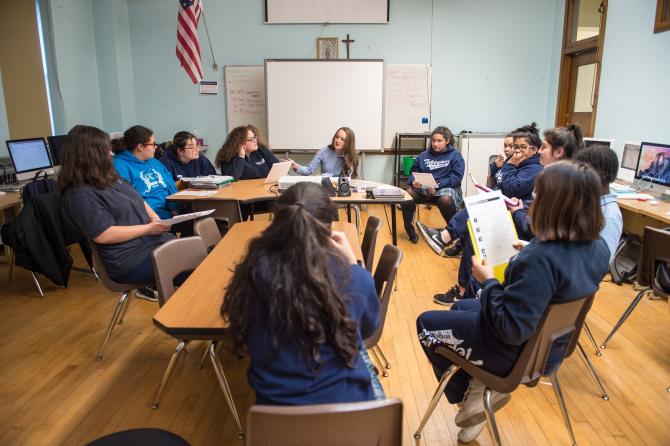Move from “Stop Talking” to “Start Talking!” // The Importance of Building a Dialogic Classroom (Part 1 of 2)
As English Language Arts educators, we have high expectations for our students when it comes to the reading and writing skills they are meant to develop in our classrooms. While we expect that students can achieve reading and writing greatness while they are with us, we would never assume, at any grade level, that our students could come into our classrooms already reading and writing at a proficient level; rather, we assess where our students are at when we meet them and then, through rigorous, relevant instruction, push them onto higher levels of reading and writing throughout our time together.
Similarly, we should not assume that students come to our classrooms already armed with proficient speaking and listening skills. This is a common pitfall I often see young teachers make in my work as a professor and a supervisor; many teachers do not take the time to explicitly teach students how to pose deep, thought-provoking questions, how to respectfully frame their thoughts in dialogue with another, or how to listen attentively in conversation. Many teachers may just assume that students have picked up these skills along the way. Intentionally cultivating authentic learning talk in our classrooms is just as important—and difficult—as the teaching of the many other skills we impart in the ELA classroom.
This post is meant to clarify and support teachers in building a culture of talk in their own classrooms. In simple terms, I think about a dialogic classroom as a disposition, an orientation, a fundamental way of being in the classroom. We may thus liken a dialogic classroom to a culture rather than just a strategy, practice, or tool used “here and there” to get students talking. In my experience, teachers who have established this culture of dialogue in their classrooms consistently promote two particular practices: the proliferation of student voice and talking-to-learn.
 If we think about dialogic talk as a pedagogical culture, then we can imagine classrooms that move away from outdated notions of schooling: a teacher stands at the front of all the wooden desks neatly arranged in rows, lecturing her students. She is the intellectual authority in the room, and the students are but empty vessels waiting to be filled with the knowledge she possesses. A dialogic culture deconstructs this transmissive model of teaching and moves toward a participatory model that encourages students to—in addition to reading-to-learn and writing-to-learn—talk-to-learn.
If we think about dialogic talk as a pedagogical culture, then we can imagine classrooms that move away from outdated notions of schooling: a teacher stands at the front of all the wooden desks neatly arranged in rows, lecturing her students. She is the intellectual authority in the room, and the students are but empty vessels waiting to be filled with the knowledge she possesses. A dialogic culture deconstructs this transmissive model of teaching and moves toward a participatory model that encourages students to—in addition to reading-to-learn and writing-to-learn—talk-to-learn.
Talking-to-learn implies some shared responsibility with students as they grapple with a difficult, probing question or rigorous task. In the process of this learning talk (or talking-to-learn), student “voice” in a myriad of forms (e.g., oral talk in pairs or large or small groups, writing in notebooks or with graphic organizers, board work, self-created anchor charts or schemata, etc.) dominates the classroom environment toward an academic end, whether around some narrowed goal or a larger, exploratory concept or question (or anywhere in between).

While oral talk tends to be the overriding feature of a dialogic classroom, the two concepts need not be explicitly conflated. I’ve heard of a teacher who often holds “silent discussions,” a dialogue where students write their thoughts and respond to those of others on a piece of paper they share between partners or with a larger group. Regardless of whether these conversations are spoken, written, or even texted, these discussions empower our students and democratize our classrooms. A dialogic culture views the student as an inquisitive thinker who is capable of drawing well-reasoned conclusions and high-level problem-solving. This culture pushes back against the idea of an all-knowing teacher who is the gatekeeper of all important information; rather, she is a partner in learning, investigating complex questions alongside her students and even learning from their insights in the process.
Research has continually shown over time the merits of a strong culture of talk in classrooms across content and grade level (see here: elementary science and elementary math, for example). Productive learning talk can increase disciplinary literacies, support academic achievement, further enhance a productive learning environment, promote equity (by allowing students’ voices to be heard and explored), and prepare students for meaningful engagement in public and civil discourse. Several teacher preparation programs, including our own ACE program, and even the Common Core recognize the benefits of productive talk, and therefore value and prioritize a dialogic classroom as a core commitment and value.

In terms of our own program, we aspire our teachers to:
- ask a range of questions that both advance learning goals and are sequenced in such a way as to build student understanding from the simple to the more complex.
- ask high-quality questions that challenge students to thoughtfully consider and offer extended responses and justify their thinking with evidence.
- employ strategies, such as preparing for dialogue with graphic organizers or giving students discussion sentence stems with which to frame their thoughts, designed to help students pose appropriate questions and create meaningful dialogue with one another.
- create a culture of participation that features students contributing thoughtfully and enthusiastically.
More often than not, teachers tend to rely on whole-class discussion to evince a dialogic classroom, but learning talk can actually be difficult to achieve in the context of a whole-class discussion. In the next post, I’ll share proven strategies for cultivating a meaningful whole-class discussion.
Happy Reading,

